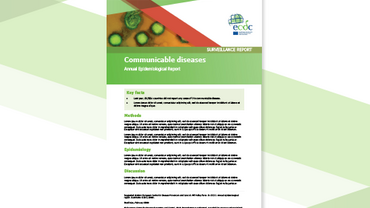Sexually transmitted infections, including HIV and blood-borne viruses - Annual epidemiological report 2014 [2012 data]
ECDC publishes the sexually transmitted infections including HIV and blood-borne viruses chapter of the Annual Epidemiological Report 2014. It includes data from 2012 on the following diseases: chlamydia, gonorrhoea, hepatitis B virus infection, hepatitis C virus infection, HIV/AIDS and syphilis.
The Annual Epidemiological Report is a key ECDC publication on the epidemiology of communicable diseases of public health significance in Europe. In order to facilitate more timely publication, the 2014 edition of the Annual Epidemiological Report is being published a disease group at a time and will later be compiled into one comprehensive report.
Executive summary
The annual report provides an overview of the epidemiology of the following diseases based on 2012 data:
Chlamydia
Chlamydia is the most frequently reported sexually transmitted infection (STI) in the countries of the European Union and European Economic Area (EU/EEA). In 2012, 384 105 cases of chlamydia were reported in 25 EU/EEA Member States. The true incidence of chlamydia is likely to be higher due to asymptomatic infections and differences in diagnostic practices and surveillance systems across Europe which can cause underreporting. Two thirds (68%) of all chlamydia cases were reported in young people between 15 and 24 years of age, with the highest rate reported among women aged 20 to 24 years (1 683 cases per 100 000), although this is influenced by the screening opportunities for this age group.
Gonorrhoea
With 50 341 cases notified by 29 EU/EEA countries, gonorrhoea is the second most commonly reported bacterial STI in Europe. The number of recorded gonorrhoea cases increased by 58% between 2008 and 2012, with most countries reporting increasing trends. Control of gonorrhoea relies entirely on antibiotics and is currently being challenged by emerging resistance to third-generation cephalosporins.
Hepatitis B infection
In 2012, 17 291cases of hepatitis B virus infection were reported by 28 EU/EEA countries. 2 952 (17.1%) of these reported cases were classified as acute infection and 12 306 (71.2%) were chronic. For both acute and chronic cases the rates were highest in the age group of 25 to 34 year-olds. Most individuals infected with the hepatitis B virus have no acute clinical symptoms and up to 25% resolve the infection spontaneously. Those chronically infected have a subsequent risk of developing liver disease.
Hepatitis C infection
30 483 cases of hepatitis C were reported in 26 EU/ EEA Member States in 2012. Of those, 509 (1.7%) were reported as ‘acute’, 3 905 (12.8%) as ‘chronic’ and 23 712 (77.8%) as ‘unknown’. Whilst some of those infected with the virus will naturally clear it from their body, approximately 75% of acute cases become chronically infected. Chronic hepatitis C virus infection may result in cirrhosis in up to 35% of patients.
HIV/AIDS
The 29 306 diagnosed cases of HIV infection reported in 29 EU/EEA countries in 2012 are likely to be an underestimation due to the delay in reporting HIV diagnoses in a number of countries. The highest proportion of infections was reported among men who have sex with men (40%); heterosexual contact accounted for 34% and injecting drug use for 6% of new HIV infections.
In 2012, 4 285 diagnoses of AIDS were reported in 28 EU/EEA countries. Overall, there has been a 42% decrease in AIDS cases since 2008, when 7 438 cases were recorded.
Syphilis
In 2012, 20 769 syphilis cases were reported by 29 EU/EEA Member States. The majority of cases were reported among people older than 25 years. The long-term trend has been declining overall, however a growing proportion of countries are reporting increasing rates in recent years. Rates are increasing mainly among men, suggesting that this may be influenced by increased transmission of syphilis among men who have sex with men.
New publication format
The Annual Epidemiological Report is a key ECDC publication on the epidemiology of communicable diseases of public health significance in Europe. In order to facilitate more timely publication, the 2014 edition of the Annual Epidemiological Report is being published a disease group at a time and will later be compiled into one comprehensive report.
Download
Publication data
Data
Number and rates of chlamydia reported cases, EU/EEA, 2008–2012
Downloadable Microsoft Excel file
Data
Number and rates of hepatitis B reported cases, EU/EEA, 2009–2012
Downloadable Microsoft Excel file
Data
Number and rates of hepatitis C reported cases, EU/EEA, 2009–2012
Downloadable Microsoft Excel file
Data
Number and rates of confirmed HIV reported infections, EU/EEA, 2008–2012
Downloadable Microsoft Excel file
Data
Number and rates of confirmed AIDS reported diagnoses, EU/EEA, 2008–2012
Downloadable Microsoft Excel file
Data
Number and rates of syphilis reported cases, EU/EEA, 2008–2012
Downloadable Microsoft Excel file





